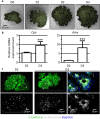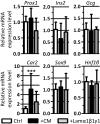Pancreatic acinar differentiation is guided by differential laminin deposition
- PMID: 30804366
- PMCID: PMC6389953
- DOI: 10.1038/s41598-019-39077-6
Pancreatic acinar differentiation is guided by differential laminin deposition
Abstract
Endothelial cells play multiple roles during pancreas organogenesis. First, they are required to instruct endoderm-derived pancreatic progenitor cells to initiate branching morphogenesis. Later, blood vessels promote β-cell differentiation but also limit acinar development. In this work, we show how endothelial cells might signal to pancreatic progenitors and spatially regulate acinar differentiation. Using an ex vivo culture system of undifferentiated E12.5 pancreata, we demonstrate that embryonic endothelial progenitor cells and their conditioned medium prevent the expression of two members of the pro-acinar transcriptional PTF1L-complex. This effect is not mediated by SPARC, a protein abundantly released in the medium conditioned by endothelial progenitors. On the contrary, heterotrimeric laminin-α1β1γ1, also produced by endothelial progenitor cells, can repress acinar differentiation when used on its own on pancreatic explants. Lastly, we found that laminin-α1 is predominantly found in vivo around the pancreatic trunk cells, as compared to the tip cells, at E14.5. In conclusion, we propose that expression or deposition of laminin-α1β1γ1 around the trunk cells, where blood vessels are predominantly localized, prevent acinar differentiation of these cells. On the contrary, transient decreased expression or deposition of laminin-α1β1γ1 around the tip cells would allow PTF1L-complex formation and acinar differentiation.
Conflict of interest statement
The authors declare no competing interests.
Figures







Similar articles
-
Epithelial: Endothelial cross-talk regulates exocrine differentiation in developing pancreas.Dev Biol. 2010 Nov 1;347(1):216-27. doi: 10.1016/j.ydbio.2010.08.024. Epub 2010 Aug 31. Dev Biol. 2010. PMID: 20807526
-
Exocrine ontogenies: on the development of pancreatic acinar, ductal and centroacinar cells.Semin Cell Dev Biol. 2012 Aug;23(6):711-9. doi: 10.1016/j.semcdb.2012.06.008. Epub 2012 Jun 26. Semin Cell Dev Biol. 2012. PMID: 22743232 Free PMC article. Review.
-
Retinoid signaling controls mouse pancreatic exocrine lineage selection through epithelial-mesenchymal interactions.Gastroenterology. 2002 Oct;123(4):1331-40. doi: 10.1053/gast.2002.35949. Gastroenterology. 2002. PMID: 12360493
-
Mechanistic elucidation of human pancreatic acinar development using single-cell transcriptome analysis on a human iPSC differentiation model.Sci Rep. 2025 Feb 7;15(1):4668. doi: 10.1038/s41598-025-88690-1. Sci Rep. 2025. PMID: 39920294 Free PMC article.
-
Acinar cell reprogramming: a clinically important target in pancreatic disease.Epigenomics. 2015;7(2):267-81. doi: 10.2217/epi.14.83. Epigenomics. 2015. PMID: 25942535 Review.
Cited by
-
Transformer for one stop interpretable cell type annotation.Nat Commun. 2023 Jan 14;14(1):223. doi: 10.1038/s41467-023-35923-4. Nat Commun. 2023. PMID: 36641532 Free PMC article.
-
In-Depth Analysis of the Pancreatic Extracellular Matrix during Development for Next-Generation Tissue Engineering.Int J Mol Sci. 2023 Jun 17;24(12):10268. doi: 10.3390/ijms241210268. Int J Mol Sci. 2023. PMID: 37373416 Free PMC article.
-
BRAFV600E Induction in Thyrocytes Triggers Important Changes in the miRNAs Content and the Populations of Extracellular Vesicles Released in Thyroid Tumor Microenvironment.Biomedicines. 2022 Mar 23;10(4):755. doi: 10.3390/biomedicines10040755. Biomedicines. 2022. PMID: 35453506 Free PMC article.
-
Focal adhesion kinase-mediated signaling controls the onset of pancreatic cell differentiation.Development. 2022 Sep 1;149(17):dev200761. doi: 10.1242/dev.200761. Epub 2022 Sep 8. Development. 2022. PMID: 36017799 Free PMC article.
-
Pancreatic progenitor epigenome maps prioritize type 2 diabetes risk genes with roles in development.Elife. 2021 Feb 5;10:e59067. doi: 10.7554/eLife.59067. Elife. 2021. PMID: 33544077 Free PMC article.
References
-
- Larsen, H. L. & Grapin-Botton, A. The molecular and morphogenetic basis of pancreas organogenesis. Seminars in Cell & Developmental Biology66, 51–68 (2017). - PubMed
-
- Zhou, Q. et al. A Multipotent Progenitor Domain Guides Pancreatic Organogenesis. Developmental Cell13(1), 103–114 (2007). - PubMed
-
- Kim SK, Hebrok M, Melton DA. Notochord to endoderm signaling is required for pancreas development. Development. 1997;124:4243–4252. - PubMed
Publication types
MeSH terms
Substances
LinkOut - more resources
Full Text Sources
Miscellaneous

